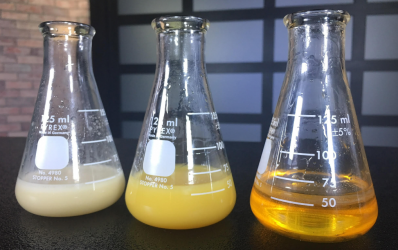Die Themen Wasser und Methanol sollte man trennen. Folgendes bezieht sich auf die Effekte von Methanol, die es auf Motor und Motoröl hat sobald es mit Motoröl in Kontakt kommt.
Was sagt die Wissenschaft dazu?
"Methanol is essentially insoluble in oil, but, on entering the oil during cold starts, forms an emulsion which can be stable for several hours or several years .(...) upper-cylinder wear is more pronounced under conditions in which methanol and its combustion products are likely to be found in the oil. In addition emulsion sludges have plugged filters or formed deposits in various locations in the engine"
Quelle:
LINK (General Motors - Abteilung für Betriebsstoffe)
Effekte von Methanol auf Motoröl und seine Additive:
"The test result indicates that the detergent-dispersant performance, antiwear performance, oxidation performance and low temperature performance were effect
negatively. The methanol gasoline with medium ingredient methanol has more significant influence. Road test result shows that
gasoline oil got worse quickly, and
periods of oil change got shorter using the methanol gasoline with 15% methanol.
The integrated analysis indicated that methanol gasoline has great negative impact on engine oil."
Quelle:
LINK
Effekte von Methanol/Wasser auf Motor und Öl bzw. ein Vergleich von Ölen, die dieses Gemisch besser vertragen sollen (Motortest über 50 Std. mit Ölproben nach jeweils 10 Std.)
"In the engine test it was observed that accumulations of
wear metal in used oil were higher with methanol fuel compared with diesel, while the TBN was lower. This suggested that the high wear may be due to contamination of lubricating oils by methanol and water. (...) It was also established that methanol and water contaminants of the lubricating oil were the principal reasons for the higher wear."
Interessant: Hatte Öl A im Versuch ohne Methanol noch den niedrigsten Eisenabrieb, ist es mit Zugabe von Methanol das Schlusslicht. Interessant: Andere Öle verhalten sich dagegen nicht so.

Statement: (2) The presence of a polar hydroxyl group renders it
more corrosive to engineering metals, i.e. iron, zinc, lead, magnesium, aluminium and copper.
Conclusion:
1) The principal mechanism of higher wear in methanol-fueled engines appears to be due to methanol and water contamination of the lubricating oil film.
(2)
Conventional oils are not capable of controlling higher wear in methanol engines. This, however, can be controlled by formulations modified by the presence of more polar/metal sensitive additive systems.
(3) The four-ball tests have shown that the combined effect of
methanol and water contamination promotes wear more significantly than either of the dilutants individually. Hence, the wear is severe in methanol-fueled engines as both the contaminants are present.
Quelle:
LINK
SAE Paper:
"...using methanol as a fuel generally promotes a cleaner lubricant environment but also induces significantly greater engine wear compared to gasoline. This wear affects engine operation and durability. However, optimized lubricant formulations can provide acceptable engine performance..."
Quelle:
LINK
Engine Labs-Blog zu dem Thema Ölkompatibilität:
"Here is a photo of
three different oils mixed with the same amount of methanol. As you can see, different oils handle the methanol differently. You can also see why it’s called “milking” of the oil, which is different from blowing a headgasket and creating a “milkshake.(...) With that said,
methanol injection engines require chemistry tailored to handle the extra fuel dilution that comes along with injected methanol, so the
owners of these engines should be looking for oils that are designed for methanol fuels.”

Quelle:
LINK
Additivfirma Infineum: Patentanmeldung einer Additivtechnologie, die mit Methanol gut zurecht kommen soll:
"A prepared lubricating oil composition product can be used for better solving the problems of corrosion and abrasion of the engine employing the methanol gasoline, and has high acid neutralization performance, alkaline holding performance, abrasion resistance, detergency, dispersibility and oxidation resistance, the lubrication requirements of the engine employing the methanol gasoline can be met, and the lubrication requirements of the engine employing the methanol gasoline (M5 to M100) with any proportion can be met."
Quelle:
LINK
Mein persönlicher Eindruck ist, dass das Thema im Rennsport beherrschbar ist, weil dort die Motoren nur eine sehr begrenzte Zeit halten müssen, die Ölintervalle und Standzeiten ultrakurz sind, der Betrieb extrem und die Auswirkungen des Methanoleintrags erst dann zu Tage treten wenn die Motoren eh vor der Überholung stehen. Für die kommenden Euro 7-Motoren (Lambda 1), die Wasser a.) zur Kolbenkühlung bei Volllast und b.) nutzen um im Schleichbetrieb Kraftstoff zu sparen wird es sehr spannend sein welcher Hersteller auf diese Technologie im
Serienbetrieb beherrscht. Ich denke da nur an die Wassereinspritzung für den Hybridmotor, der die meiste Zeit steht, weil das Auto 70km E-Reichweite hat.
Beim M4 GTS hat man es entweder Ölseitig super gelöst oder man geht schlicht davon aus, dass die wenigen GTS, die ausschließlich zum Brötchen holen verwendet werden, irgendwann auf Kulanz repariert werden. So viele werden es schliesslich nicht sein.
Ich wäre bei den bunten YouTube-Clips immer vorsichtig, besonders dann wenn einem etwas verkauft wird, das angeblich keine oder kaum Nachteile hat oder der einzige Nachteil darin besteht, dass die Anlage teuer ist.





